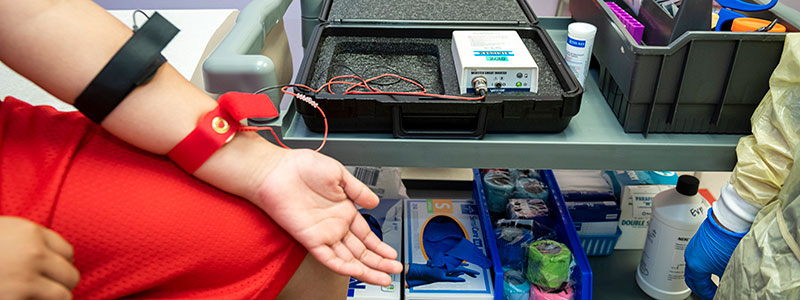Pediatric Cystic Fibrosis (CF) Sweat Test
Children’s Health is home to some of the nation’s top experts in caring for children with cystic fibrosis (CF). Our team provides testing and treatment for over 300 children with cystic fibrosis every year, helping them build a healthier future.

What is a Pediatric Cystic Fibrosis (CF) Sweat Test?
Cystic fibrosis (CF) causes an imbalance of water and salt in the body, resulting in thick mucus and excessive loss of salt in sweat. When mucus in the body is thick, breathing or processing food can become difficult.
If your doctor thinks your child may have CF, Children’s Health℠ uses sweat tests (also called cystic fibrosis chloride sweat tests) as a safe and painless way to get answers. The test collects and measures the salt (chloride) in an adult’s or child’s sweat. Higher levels than usual may mean your child has CF.
If your child’s sweat test is positive, your child will be referred to the CF clinic at Children’s Health for further evaluation and treatment.
What can I expect with a Pediatric Cystic Fibrosis (CF) Sweat Test?
People with CF usually have higher levels of chloride (salt) in their sweat than people who don’t have CF. A cystic fibrosis sweat test is a fast and painless way to check if your child has high levels of chloride in their sweat. Your doctor may recommend a sweat test for your child if:
- You have a diagnosis of CF which could be passed on to your child
- Your baby’s newborn screening test for CF is abnormal
- Your child is experiencing possible symptoms of CF, including:
- Loose, frequent and oily stools
- Difficulty gaining weight
- Repeated pneumonia
- Difficulty breathing
What to expect during a Pediatric Cystic Fibrosis (CF) Sweat Test?
The CF sweat test will last about an hour, during which the lab technician will collect and measure the sweat on your child’s arm. You will be able to take your child home after the test.
Step 1: Make the arm sweat
The lab technician will wash and dry a small patch of skin on each arm. Then they will add a few drops of solution (called pilocarpine) on each arm and gently place a disc (called an electrode) on each spot. The disc sends a tiny amount of electrical current to the skin, making the skin start to sweat. Your child will probably feel some tingling during the test, like when your arm falls asleep.
Step 2: Collect and measure
Once the skin is sweating, the lab technician will remove the electrode and clean the area. Then they will place plastic disc back on the arm to collect the sweat. They’ll wrap it all up with clear film, a warm pack, and a (nonstick) bandage to keep the skin sweating. The disc will stay on your child’s arm for 30 minutes until enough sweat is collected to be measured.
What to expect after a Pediatric Cystic Fibrosis (CF) Sweat Test?
Results from the sweat test are usually ready in one to two days and will typically fall within three levels:
- Normal. 29 mmol/L or below
- Middle. 30-59 mmol/L
- High. 60 or more mmol/L or higher
If the results come back in the middle or high range (or are unclear), your child will need to repeat the sweat test. Depending on these results, your doctor may suggest another type of test, like a cheek swab or blood test.
Our team of experts will walk you through the next steps in your child’s care. If your child is diagnosed with CF, we have a dedicated Cystic Fibrosis Program and care team with specialists that work with your child to improve both their lung and digestive health. Our state-of-the-art lab helps us deliver customized care to get your child breathing, playing, and feeling better.
How do I prepare my child for a Pediatric Cystic Fibrosis (CF) Sweat Test?
There are a few things you can do to help get your child ready for a sweat test, including:
- Bathe them the night before or the morning of the test
- Don’t apply anything to their clean skin, like lotion or powder
- Make sure your child is well hydrated the day before. They can drink water, Gatorade®, milk or their formula, as usual.
- Bring things to help your child stay comfortable and warm (so it’s easier for them to sweat), including extra water/formula/Gatorade, extra clothing or blankets, and toys to keep them busy
- Keep giving your child any medications they are currently taking
- Give the outpatient lab a call if your child is sick the day before your test, especially if they are vomiting or have diarrhea
What questions should I ask my provider about a Pediatric Cystic Fibrosis (CF) Sweat Test?
Examples include:
- How many cystic fibrosis (CF) sweat tests have you performed?
- Will other testing be required after the cystic fibrosis sweat test?
- How reliable is the cystic fibrosis sweat test?
- Are there any risks or side effects of the cystic fibrosis sweat test?
Pediatric Cystic Fibrosis (CF) Sweat Test Doctors and Providers
-
1285788489
 Preeti Sharma, MD Pediatric Pulmonologist
Preeti Sharma, MD Pediatric Pulmonologist -
1225240096
 Meghana Sathe, MD Pediatric Gastroenterologist
Meghana Sathe, MD Pediatric Gastroenterologist
Frequently Asked Questions
-
Is cystic fibrosis diagnosed using a sweat test?
Yes. Sweat tests are a safe, painless way to determine if someone has cystic fibrosis. We perform sweat tests for adults, children and babies to identify CF quickly and reliably and start treatment fast.
-
What is a positive sweat test?
A positive sweat test means it is likely that the person who was tested has CF. Uncommonly, a positive sweat test could mean that there are other things happening to cause symptoms, like problems with the adrenal, thyroid and pituitary glands. If your doctor suspects any of these conditions, they will request additional testing.
-
How do I understand the cystic fibrosis sweat test results?
The results of the cystic fibrosis sweat test will show how much chloride is in the sweat of the person who was tested. Results are measured in millimole per liter (mmol/L) and fall into three categories: normal (less than 30 mmol/L), intermediate (30-59 mmol/L) and high (60 or higher).
Results in the normal range means CF is unlikely. Results in the intermediate range are unclear and additional testing will likely be needed. Results in the higher range mean that CF is likely, and your care team will need to do some more follow up.